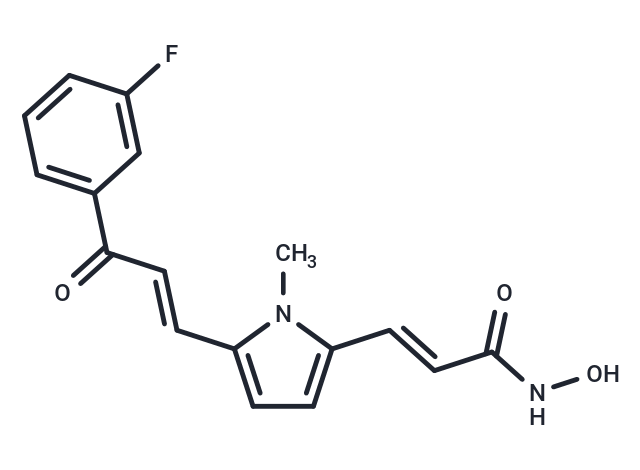购物车
- 全部删除
 您的购物车当前为空
您的购物车当前为空

MC1568是一种针对玉米 HD1-A 的特异性 HDAC 抑制剂,在无细胞试验中的IC50为100 nM,可用于癌症研究。


为众多的药物研发团队赋能,
让新药发现更简单!
MC1568是一种针对玉米 HD1-A 的特异性 HDAC 抑制剂,在无细胞试验中的IC50为100 nM,可用于癌症研究。
| 规格 | 价格 | 库存 | 数量 |
|---|---|---|---|
| 5 mg | ¥ 257 | 现货 | |
| 10 mg | ¥ 413 | 现货 | |
| 25 mg | ¥ 739 | 现货 | |
| 50 mg | ¥ 1,230 | 现货 | |
| 100 mg | ¥ 2,310 | 现货 | |
| 200 mg | ¥ 3,450 | 期货 | |
| 1 mL x 10 mM (in DMSO) | ¥ 343 | 现货 |
| 产品描述 | MC1568 is a specific HDAC inhibitor for maize HD1-A (IC50: 100 nM, in a cell-free assay). It is 34-fold more selective for HD1-A than HD1-B. |
| 靶点活性 | HD1-A (Maize):100 nM |
| 体外活性 | 在胰脏移植研究中,MC1568增强内分泌β和δ-cells细胞,并使Pax4的表达增强. 在鼠体内,MC1568(50 mg/kg)组织选择性地显著抑制HDAC. 在PPRE-Luc鼠体内,MC1568(50 mg/kg)主要损害心脏和脂肪组织部位PPARγ信号.作用于骨骼肌和心脏时,MC1568抑制HDAC4/5的活性,不影响HDAC3活性,故MEF2-HDAC复合体处于未激活状态. |
| 体内活性 | MC1568对HDAC II的选择性抑制效果(IC50:220 nM)是I型的176倍。作用于C2C12细胞时,MC1568(5 μM)通过降低肌细胞增强因子2D的表达,使HDAC4-HDAC3-MEF2D复合体稳定,并抑制分化诱导的MEF2D乙酰化,从而使肌细胞生成被阻断。MC1568(5或10 μM)可使RAR和PPARγ调节的分化诱导信号通路受干扰。 在MCF-7细胞中,MC1568(20 μM)使乙酰化H3和H4组蛋白的累积增强,并提高乙酰基微管蛋白的水平,表明MC1568可抑制HDAC6。作用于人类乳腺癌ZR-75.1细胞裂解物时,MC1568对HDAC1无抑制作用,但是可使HDAC4受抑制。作用于F9细胞时,MC1568选择性抑制内胚分化,对VA诱导的早幼粒NB4细胞成熟无影响。作用于3T3-L1细胞时,MC1568使PPARγ诱导的脂肪生成降低。 |
| 激酶实验 | Maize HD2, HD1-B, and HD1-A Enzyme Inhibition.: The enzyme liberats tritiated acetic acid from the substrate, which is quantified by scintillation counting. IC50 values are results of triple determinations. A 50 μL sample of maize enzyme (at 30 °C) is incubated (30 min) with 10 μL of total [3H]acetate-prelabeled chicken reticulocyte histones (2 mg/mL). Reaction is stopped by addition of 50 μL of 1 M HCl/0.4 M acetate and 800 μL of ethyl acetate. After centrifugation (1×104 g, 5 min), an aliquot of 600 μL of the upper phase is counted for radioactivity in 3 mL of liquid scintillation cocktail. MC1568 is tested at a starting concentration of 40 μM, and active substances are diluted further. NaB, VPA, TSA, SAHA, 85 TPX, HC-toxin, and tubacin are used as the reference compounds, and blank solvents are used as negative controls. |
| 细胞实验 | The 3T3-L1 cells are propagated and differentiated using a cocktail of isobutylmethylxanthine, dexamethasone, and insulin. From the second day post-confluence and throughout the differentiation period of 8 days, the 3T3-L1 cells are induced by: (1) no induction: at post-confluence and throughout the differentiation period of 8 days, the cells are incubated with DMSO or MC1568. (2) troglitazone: at post-confluence and throughout the differentiation period of 8 days, the cells are induced with 5 μM troglitazone, MC1568, or both. (3) rosiglitazone: at post-confluence and throughout the differentiation period of 8 days, the cells are incubated with 1?μM rosiglitazone and either DMSO or MC1568. (4) rosiglitazone and dexamethasone: at post-confluence, the cells received 1?μM of rosiglitazone and 390?ng/mL dexamethasone. Throughout the differentiation period of 8 days, the cells are induced with 1?μM of rosiglitazone and either DMSO or MC1568. All medium is renewed every second day.(Only for Reference) |
| 分子量 | 314.31 |
| 分子式 | C17H15FN2O3 |
| CAS No. | 852475-26-4 |
| Smiles | Cn1c(\C=C\C(=O)NO)ccc1\C=C\C(=O)c1cccc(F)c1 |
| 密度 | 1.21 g/cm3 (Predicted) |
| 存储 | Powder: -20°C for 3 years | In solvent: -80°C for 1 year | Shipping with blue ice. | |||||||||||||||||||||||||
| 溶解度信息 | H2O: < 1 mg/mL (insoluble or slightly soluble) Ethanol: < 1 mg/mL (insoluble or slightly soluble) DMSO: 11 mg/mL (35 mM), Sonication is recommended. | |||||||||||||||||||||||||
溶液配制表 | ||||||||||||||||||||||||||
DMSO
| ||||||||||||||||||||||||||
评论内容